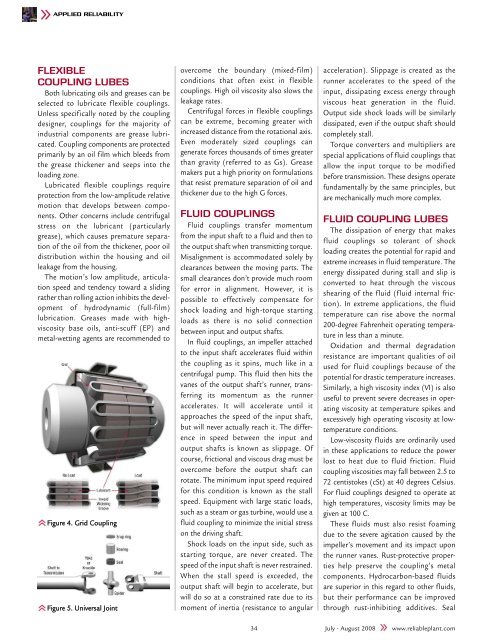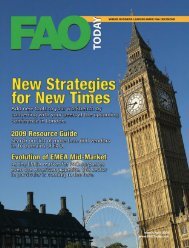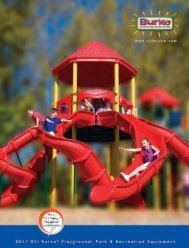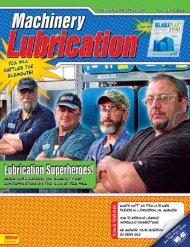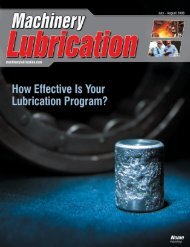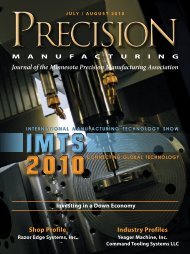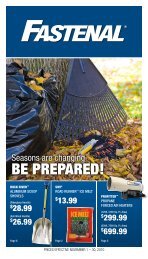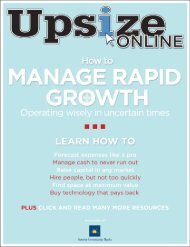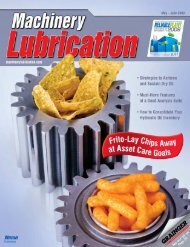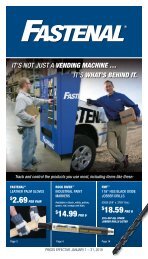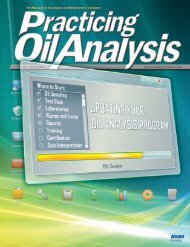Reliable Plant July August 2008
Reliable Plant July August 2008
Reliable Plant July August 2008
Create successful ePaper yourself
Turn your PDF publications into a flip-book with our unique Google optimized e-Paper software.
APPLIED RELIABILITY<br />
FLEXIBLE<br />
COUPLING LUBES<br />
Both lubricating oils and greases can be<br />
selected to lubricate flexible couplings.<br />
Unless specifically noted by the coupling<br />
designer, couplings for the majority of<br />
industrial components are grease lubricated.<br />
Coupling components are protected<br />
primarily by an oil film which bleeds from<br />
the grease thickener and seeps into the<br />
loading zone.<br />
Lubricated flexible couplings require<br />
protection from the low-amplitude relative<br />
motion that develops between components.<br />
Other concerns include centrifugal<br />
stress on the lubricant (particularly<br />
grease), which causes premature separation<br />
of the oil from the thickener, poor oil<br />
distribution within the housing and oil<br />
leakage from the housing.<br />
The motion’s low amplitude, articulation<br />
speed and tendency toward a sliding<br />
rather than rolling action inhibits the development<br />
of hydrodynamic (full-film)<br />
lubrication. Greases made with highviscosity<br />
base oils, anti-scuff (EP) and<br />
metal-wetting agents are recommended to<br />
Figure 4. Grid Coupling<br />
Figure 5. Universal Joint<br />
overcome the boundary (mixed-film)<br />
conditions that often exist in flexible<br />
couplings. High oil viscosity also slows the<br />
leakage rates.<br />
Centrifugal forces in flexible couplings<br />
can be extreme, becoming greater with<br />
increased distance from the rotational axis.<br />
Even moderately sized couplings can<br />
generate forces thousands of times greater<br />
than gravity (referred to as Gs). Grease<br />
makers put a high priority on formulations<br />
that resist premature separation of oil and<br />
thickener due to the high G forces.<br />
FLUID COUPLINGS<br />
Fluid couplings transfer momentum<br />
from the input shaft to a fluid and then to<br />
the output shaft when transmitting torque.<br />
Misalignment is accommodated solely by<br />
clearances between the moving parts. The<br />
small clearances don’t provide much room<br />
for error in alignment. However, it is<br />
possible to effectively compensate for<br />
shock loading and high-torque starting<br />
loads as there is no solid connection<br />
between input and output shafts.<br />
In fluid couplings, an impeller attached<br />
to the input shaft accelerates fluid within<br />
the coupling as it spins, much like in a<br />
centrifugal pump. This fluid then hits the<br />
vanes of the output shaft’s runner, transferring<br />
its momentum as the runner<br />
accelerates. It will accelerate until it<br />
approaches the speed of the input shaft,<br />
but will never actually reach it. The difference<br />
in speed between the input and<br />
output shafts is known as slippage. Of<br />
course, frictional and viscous drag must be<br />
overcome before the output shaft can<br />
rotate. The minimum input speed required<br />
for this condition is known as the stall<br />
speed. Equipment with large static loads,<br />
such as a steam or gas turbine, would use a<br />
fluid coupling to minimize the initial stress<br />
on the driving shaft.<br />
Shock loads on the input side, such as<br />
starting torque, are never created. The<br />
speed of the input shaft is never restrained.<br />
When the stall speed is exceeded, the<br />
output shaft will begin to accelerate, but<br />
will do so at a constrained rate due to its<br />
moment of inertia (resistance to angular<br />
acceleration). Slippage is created as the<br />
runner accelerates to the speed of the<br />
input, dissipating excess energy through<br />
viscous heat generation in the fluid.<br />
Output side shock loads will be similarly<br />
dissipated, even if the output shaft should<br />
completely stall.<br />
Torque converters and multipliers are<br />
special applications of fluid couplings that<br />
allow the input torque to be modified<br />
before transmission. These designs operate<br />
fundamentally by the same principles, but<br />
are mechanically much more complex.<br />
FLUID COUPLING LUBES<br />
The dissipation of energy that makes<br />
fluid couplings so tolerant of shock<br />
loading creates the potential for rapid and<br />
extreme increases in fluid temperature. The<br />
energy dissipated during stall and slip is<br />
converted to heat through the viscous<br />
shearing of the fluid (fluid internal friction).<br />
In extreme applications, the fluid<br />
temperature can rise above the normal<br />
200-degree Fahrenheit operating temperature<br />
in less than a minute.<br />
Oxidation and thermal degradation<br />
resistance are important qualities of oil<br />
used for fluid couplings because of the<br />
potential for drastic temperature increases.<br />
Similarly, a high viscosity index (VI) is also<br />
useful to prevent severe decreases in operating<br />
viscosity at temperature spikes and<br />
excessively high operating viscosity at lowtemperature<br />
conditions.<br />
Low-viscosity fluids are ordinarily used<br />
in these applications to reduce the power<br />
lost to heat due to fluid friction. Fluid<br />
coupling viscosities may fall between 2.5 to<br />
72 centistokes (cSt) at 40 degrees Celsius.<br />
For fluid couplings designed to operate at<br />
high temperatures, viscosity limits may be<br />
given at 100 C.<br />
These fluids must also resist foaming<br />
due to the severe agitation caused by the<br />
impeller’s movement and its impact upon<br />
the runner vanes. Rust-protective properties<br />
help preserve the coupling’s metal<br />
components. Hydrocarbon-based fluids<br />
are superior in this regard to other fluids,<br />
but their performance can be improved<br />
through rust-inhibiting additives. Seal<br />
34 <strong>July</strong> - <strong>August</strong> <strong>2008</strong> www.reliableplant.com


